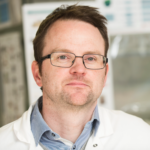Lien vers Pubmed [PMID] – 28941175
2018 Jan;70(1):134-145
OBJECTIVE: Juvenile dermatomyositis (JDM) is an inflammatory pediatric myopathy characterized by focal capillary loss in muscle, followed by progressive recovery upon adequate treatment with immunomodulating drugs, although some patients remain refractory to treatment. While the underlying mechanism of capillary depletion remains uncertain, recent studies have identified an up-regulation of type I interferon (IFN) expression specific to JDM. Given that myogenic precursor cells (MPCs) exert proangiogenic activity during normal skeletal muscle regeneration, we hypothesized that they may also modulate vascular remodeling/angiogenesis during JDM. The aim of this study was to investigate that hypothesis.
METHODS: Human cell cocultures were used to analyze angiogenic properties in patients with JDM, patients with Duchenne’s muscular dystrophy (DMD) (control patients for vascular remodeling), and healthy control subjects. Transcriptome analysis was used to examine muscle-derived MPCs. Histologic analysis of type I IFN in muscle biopsy samples was also performed.
RESULTS: Using human cell cocultures, we showed highly angiogenic properties of MPCs from JDM patients in association with the expression of an angiogenic molecular signature. Transcriptome analysis of MPCs freshly isolated from muscle samples revealed type I IFN as the master regulator of the most up-regulated genes in JDM-derived MPCs. Functionally, treatment of normal MPCs with type I IFN recapitulated the molecular pattern and the proangiogenic functions of JDM-derived MPCs. In vivo histologic investigation showed that MPCs synthesized type I IFN and major proangiogenic molecules in JDM muscle. Moreover, MPCs derived from JDM muscles that were characterized by strong vasculopathy produced higher levels of type I IFN, confirming MPCs as a cellular source of type I IFN during JDM, and this correlated with the severity of the disease.
CONCLUSION: These results demonstrate a new type I IFN pathway in JDM that activates the production of angiogenic effectors by MPCs, triggering their proangiogenic function to promote vessel recovery and muscle reconstruction.


